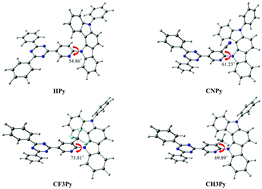A study on the effect of a pyridine secondary acceptor on the emission properties of thermally activated delayed fluorescence emitters†
Abstract
In this study, a new molecular design of thermally activated delayed fluorescence (TADF) emitters having a pyridine derived secondary acceptor was developed. Four TADF emitters were designed and synthesized to study the effect of the pyridine derived secondary acceptor on their TADF properties and device performances were investigated. The four TADF emitters, HPy, CNPy, CF3Py and CH3Py, with a pyridine secondary acceptor decorated by functional groups were developed as an approach to manage the emission wavelength and to improve efficiency roll-off characteristics of green TADF organic light-emitting diodes by decreasing the delayed fluorescence lifetime. The pyridine secondary acceptor based TADF emitters showed short delayed fluorescence lifetimes, and the TADF emitter with the methyl group functionalized pyridine secondary acceptor achieved a high external quantum efficiency (EQE) of over 20% and little efficiency roll-off up to 1000 cd m−2. Therefore, the pyridine secondary acceptor based molecular design was effective to manage the delayed fluorescence lifetime of the TADF emitters, and external quantum efficiency and efficiency roll-off of the TADF devices.



 Please wait while we load your content...
Please wait while we load your content...